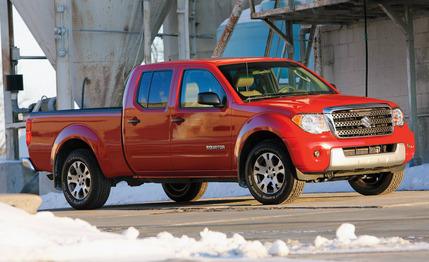 Short Take Road Test
Short Take Road Test
Among compact pickups, the Suzuki Equator breaks no new ground, yet surely represents The New Frontier. Why? Because that’s what it is: a Nissan Frontier with a fat chrome Superman “S” on its grille.
But sometimes badge engineering isn’t so awful. In a five-truck comparo [June 2005], a Frontier LE finished second to a Honda Ridgeline RTS, and we’ve come to appreciate the latest Frontier’s solid chassis, composed handling, controlled body motions, off-road prowess, and surprisingly accurate steering, which we’d praise even more lavishly if it were less heavy at parking-lot speeds.

The Equator comes in extended- and crew-cab iterations, with a five- or six-foot-long bed—a classy-looking spray-on bed liner is standard—and Nissan’s 261-hp, 4.0-liter V-6 is a must-have option that’s standard in crew cabs. It’s a strong, willing engine with endearing idle quality, although it becomes a tad thrashy above 4500 rpm. Matched to an extended-cab body, that V-6 is capable of towing 6500 pounds. Both trucks—Equator and Frontier—dispatch the quarter-mile with nearly identical speeds and ETs.
Our Equator’s fabric front seats looked good and were fantastically comfortable, but the rears feature a slab-flat seatback and a cushion so low that your knees poke up to bellybutton level. The rear cushions flip up to reveal storage bins on a flat floor, and the front-passenger seatback folds flat.
Apart from a brake pedal that was as mushy as a meadow muffin, the Equator was otherwise a composed, confidence-inspiring vehicle evincing relatively few of the shivers and quivers to which so many trucks are prone. Plus it proved unstoppable in snow.
Which, then, to buy? Well, a base Equator is $245 cheaper than a base Frontier, and our Equator cost $355 less than a comparably equipped Frontier. Then there’s this: Nissan’s powertrain warranty spans five years/60,000 miles versus Suzuki’s generous seven years/100,000 miles. Jeez, that’s four laps ’round the Equator. Er, equator.